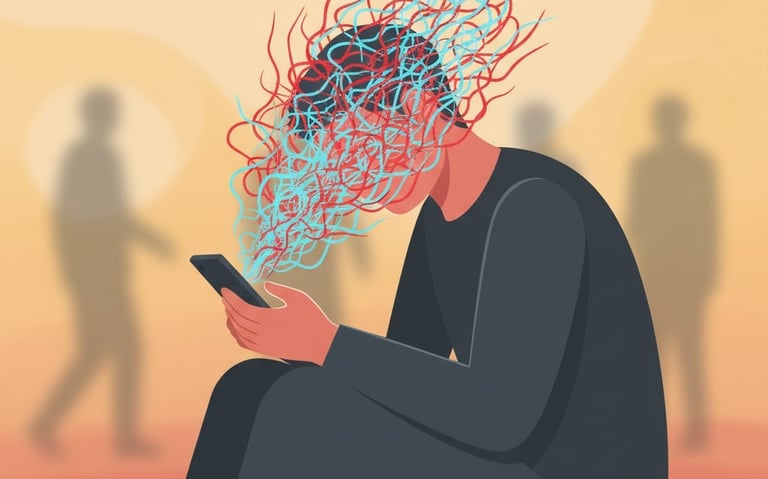Essays and Conversations on Community & Belonging
The Brain in Isolation: Understanding and Overcoming Loneliness
We often mistake loneliness for a simple feeling, but it's a powerful biological alarm system that the brain processes with the same urgency as physical pain. This primal signal triggers a cascade of neurological effects, activating our threat response, impairing rational thought, and damaging our physical health. This post explores the neuroscience of isolation, revealing how loneliness literally changes the way we perceive the world and creates a feedback loop of social withdrawal. Discover how you can leverage neuroplasticity and take small, intentional steps—from community activities to mindful digital use—to answer this signal and rewire your brain for connection.
SHORT FORM ESSAYMENTAL HEALTHSELF FULFILLMENTRESPONSE CONTENT
Alex Pilkington
11/15/20254 min read
Loneliness is often misunderstood as a simple feeling of sadness or a character flaw. In reality, it is a complex and powerful biological signal. Far from being a personal failing, loneliness is an ancient alarm system, a primal human instinct designed to signal a critical deficit: social connection. Research reveals that this signal is so fundamental that the brain processes it with the same urgency as physical injury, triggering a cascade of neurological and physical effects that can profoundly impact our health, our perception, and our ability to think.
The human brain is wired for connection, and its response to isolation is dramatic. Studies using fMRI scans have shown that social rejection and loneliness activate the same brain regions as physical pain, such as the anterior cingulate cortex. This is not a metaphor; the brain interprets profound loneliness as a genuine threat to survival. This activates a primitive threat-detection system, sometimes called neurosception, which scans the environment for danger. When this system is triggered by social isolation, it initiates a survival response, flooding the body with stress hormones. This state of high alert hyperactivates the amygdala, the brain's fear center, while simultaneously impairing the function of the prefrontal cortex, the region responsible for rational thought, emotional regulation, and decision-making.
This neurological shift has profound consequences for both mind and body. A brain steeped in chronic loneliness begins to perceive the world differently. It becomes hyper-vigilant for social threats, causing it to misinterpret neutral social interactions as hostile or rejecting. This, in turn, creates a tragic feedback loop: the lonely individual feels more threatened, withdraws further, and deepens their own isolation. This constant state of alert also wrecks havoc on physical health. Chronic loneliness is linked to disrupted sleep patterns, impaired immune function, and a higher risk of serious health issues, including heart disease and prolonged recovery times from illness.
The impact of loneliness extends deep into our cognitive faculties. When the brain is forced to divert significant resources to managing a constant, underlying state of threat, it has fewer resources left for higher-order functions. Chronic loneliness has been shown to contribute to cognitive decline and is correlated with a higher risk of developing dementia. The brain’s energy is spent on survival, not on memory consolidation or complex problem-solving. However, this is not a permanent state. The brain’s remarkable capacity for change, known as neuroplasticity, offers a powerful path forward. Re-wiring the brain is possible, and the solution lies not in amassing superficial connections, but in cultivating deeper, quality relationships with a small, core group of people.
Rebuilding social connections, especially after a period of isolation, requires a gradual and intentional approach. The brain's threat response can make social interaction feel overwhelming, so the key is to start small. Begin by engaging with "weak ties"—familiar faces in your daily life, like a barista, a neighbor, or a coworker. These low-stakes interactions can help ease social anxiety. Another strategy is to use "environmental anchors" by placing yourself in predictable, safe social settings, such as a park or library, allowing for consistent, casual interactions without pressure.
From these first steps, one can move toward more structured social activities. Joining a group focused on a shared interest—a book club, a hiking group, or a community class—provides a natural context for social interaction. The shared activity becomes the focus, removing the pressure to "be social" and allowing connections to form more organically. Furthermore, helping others, such as through volunteering, is a powerful antidote to loneliness. It activates the brain's reward pathways, provides a sense of purpose, and naturally counters the self-focused nature of isolation, improving overall well-being.
In our modern world, digital platforms can play a role, but they must be used with extreme intention, as many are now designed in ways that actively increase loneliness. The shift to an "anti-social web"—driven by engagement-maximizing algorithms rather than genuine social connection—is a key factor. Passively scrolling through these platforms does more than just displace the time that could be spent on real-world interactions; it actively feeds the brain a diet of algorithmically-selected content. Because these algorithms often promote polarizing, negative, or emotionally-charged content to maximize reactions, they can amplify the brain's threat-detection system, increase feelings of anxiety and social comparison, and distort our perception of others, worsening the very isolation we seek to cure.
True "intentional" use, therefore, means distinguishing between "consumption media" and "community media." It requires rejecting the infinite, algorithm-driven feeds that treat you as a consumer. Instead, actively participating in community-focused spaces—such as specific forums, opt-in groups, or servers based on shared interests—can provide a valuable, low-pressure arena to practice social skills. These interactions, free from an algorithm designed to anger or addict, can serve as a healthy bridge toward in-person connection. The goal is to use digital tools as a supplement for community, not a substitute for connection.
Ultimately, every small step taken toward connection helps to rewire the brain for resilience. Engaging in simple, positive social interactions begins to counteract the brain’s threat detection, teaching it that connection is safe and rewarding. By practicing empathy and perspective-taking, we not only build deeper relationships but also strengthen the neural pathways that support them. Loneliness is a painful, physical signal from our brain, but it is one we have the power to answer. Through understanding, patience, and consistent effort, we can leverage our brain's own plasticity to heal, reconnect, and thrive.





